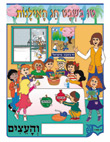| SHANA TOVA |
 The Shana Tova chapter deals with the High Holy Days of the month of Tishre'i.
It is organized into four chapters: Rosh Hashana, Yom Kippur, Sukkot and Simchat Torah.
The Shana Tova chapter deals with the High Holy Days of the month of Tishre'i.
It is organized into four chapters: Rosh Hashana, Yom Kippur, Sukkot and Simchat Torah.
The sub-units of Rosh Hashana and Yom Kippur focus on the concepts of Tefila (prayer),
Teshuva (repentance) and Tzedaka (charity), all on a level which is understandable by the students.
Prayer: Request for forgiveness following a wrong deed, thinking about the wrong deed, and a return to the good position after the request for excuse.
Charity: Fulfillment of justice and good deeds.
As well, this sub-unit deals with the Mitzvot and customs related to Sukkot holiday
and with the blessings connected to the Mitzvah of dwelling in the Suka and the handling of
the four species.
The Simchat Torah sub-unit focuses mainly on the importance of the Torah and instilling love of Torah,
encouraging the study of the Torah and the fulfillment of the Mitzvot with love.
Click here to view all Materials
|
| |
|
CHANNUKA SAMEACH |
 The Happy Channuka chapter deals with two main ideas:
The Happy Channuka chapter deals with two main ideas:
1. The story of Channuka: the struggle to maintain Jewish identity and the war against the
imposition of Greek customs.
2. The Mitzvot and the customs that commemorate, for generations to come, the story of Channuka:
The victory of the far outnumbered believers over their persecutors, and the cleansing and
purification of the Temple in order to restore the duties of God's worship in it.
This sub-unit is organized in accordance with these two main ideas, with the recommendation to
teach them in parallel, combining of the story from the past and our behavior in the present.
Happy Channuka is recommended for teaching starting from the last week of Cheshvan until the end
of Kislev.
Click here to view all Materials
|
| |
|
TU BISHVAT |
 The chapter of Tu Bishvat (Holiday of the Trees), encompasses awareness and sensitivity to the environment.
The chapter of Tu Bishvat (Holiday of the Trees), encompasses awareness and sensitivity to the environment.
This sub-unit focuses on two main ideas:
1. The tree and its parts, and
2. Why do we love trees?
It includes the Mitzvot and the customs in Israel and the Diaspora, emphasizing on the Mitzvot of eating the
fruits of the trees and the blessing of "Bore Pri Ha'etz", and planting trees in Israel on Tu Bishvat.
Tu Bishvat is intended for teaching during the month of Sh'vat.
Click here to view all Materials
|
|
| HAPPY PURIUM |
 The chapter of Happy Purim (Purim Sameach) deals with two principal ideas:
The chapter of Happy Purim (Purim Sameach) deals with two principal ideas:
1. the story of Purim as presented in Megilat Esther, focusing in the four "heroes" of the scroll: Ahasuerus,
Esther, Mordehai and Haman.
2. the Mitzvot and the customs of Purim which are directly connected to the story of Megilath Esther and keep
reminding us the concept of "Venahafoch Hu" (on the contrary): "And the month that has turned for them from sorrow
to joy and from grief to a holiday" (Esther, chapter 9, 22).
The sub-unit is organized along these two principal ideas, and is intended for teaching during the month of Adar.
We recommend to begin teaching this unit on the first day of Adar, attaching it to the custom of "When Adar starts, ...."
Click here to view all Materials
|
| |
|
FROM PESSACH TO SHAVUOT |
 The chapter From Pessach to Shavuot (Mipessach ad Shavuot) contains three main parts that are conceptually
interconnected:
The chapter From Pessach to Shavuot (Mipessach ad Shavuot) contains three main parts that are conceptually
interconnected:
1. Pessach Kasher VeSameach;
2. Counting the Omer;
3. Shavuot.
The subject of Pessach Kasher VeSameach deals, through the story of the Exodus from Egypt, with the main theme of
liberation from slavery into freedom and how this event is celebrated in our days by the Seder, including the Mitzvot
and the Hagada.
The subject of Counting the Omer (Sefirat Ha'omer) deals with the counting that starts on the
second day of Pessach and continues until Shavuot.
The topic of the Holiday of Shavuot deals mainly in the essence of the Shavuot as the holiday of the giving of the
Torah, as well as its second theme, as the holiday of First Fruits, connecting it to Jerusalem, the Temple city.
Pessach Kasher VeSameach is recommended for teaching immediately following Purim. After Pessach, we recommend investing
a short time on a daily basis for the blessing of Sefirat HaOmer and the counting itself. The sub-unit on Shavuot is
recommended for teaching after Yom HaAtzmaut (Israel's Independence Day).
Click here to view all Materials
|
| |
|
YISRAEL SHELI |
 This chapter My Israel (Yisrael Sheli) focuses on:
This chapter My Israel (Yisrael Sheli) focuses on:
1. the tie between the People of Israel and the Land of Israel;
2. identification of the People of Israel with the State of Israel and Jerusalem.
The identification is acquired and internalized through celebrating the days, as well as through the flag,
the hymn, the symbol, the emblem, and the prayer for the welfare of the State.
This sub- unit is organized along two sub-topics: Yom Ha'Atzmaut and Yom Yerushalayim.
Yom Ha'Atzmaut is recommended for teaching immediately after Pessach and until the 5th of Iyar
(Israel's Independence Day). The unit of Yom Yerushalayim is recommended for teaching during the
period between Yom Ha'Atzmaut and Yom Yerushalayim, on th 28th of Iyar.
Click here to view all Materials
|
|
|